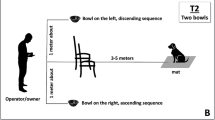Summary
-
1.
In recordings from single tympanic receptor fibres inC. biguttulus, the response to synthesized sounds (rectangularly modulated white noise) interrupted by very brief (a few milliseconds) gaps was examined. In behavioral tests, females of the species respond very differently to such ‘model syllables’ at moderate intensities, depending on the gap width. If the gaps (in a moderateintensity syllable) are larger than 2 ms, the stimulus fails to elicit a response, whereas stimuli with gaps smaller than 1 ms are as effective as uninterrupted yllables (D. von Helversen 1972; O. von Helversen 1979).
-
2.
Neither the mean spike count nor the interspike-interval distribution of the single receptor response contains the information sufficient to distinguish uninterrupted syllables from syllables with gaps (Figs. 2 and 3). On the other hand, examination of the temporal distribution of the spikes reveals that gaps (or the pulse onsets following the gaps) cause spike synchronization (Fig. 4).
-
3.
An index of synchronization (IS) was defined as a measure of this gap-induced effect (Figs. 5 and 6). Analysis of the receptor responses based on IS revealed differences that correspond quantitatively to the abrupt abolition of the behavioral response at a gap-width between 1 and 2 ms. From the hypothesis that such brief gaps are detected by the nervous system by way of spike synchronization in the tympanic nerve, one can predict certain features of the behavioral response to highintensity stimuli.
-
4.
The gap-induced spike synchronization was more pronounced at higher temperatures. This effect was demonstrated in both summated recordings from the tympanic nerve and single fibre recordings (Fig. 8).
-
5.
Experiments with primary auditory fibres ofLocusta migratoria showed that the receptors in this species respond very similarly to the same stimuli. That is, the receptors ofC. biguttulus are not specially adapted for detecting very brief gaps. Synchronization of the spikes in parallel receptor fibres of the tympanal nerve is probably a general feature of acridids; we infer that inC. biguttulus this gap-induced synchronized activity is detected by special processing in higher auditory centres.
Similar content being viewed by others
Abbreviations
- BF :
-
best frequency
- IRM :
-
innate releasing mechanism
- IS :
-
index of synchronization of spikes by gaps
- SAP :
-
summated action potentials
References
Abrams TW, Pearson KG (1982) Effects of temperature on identified central neurons that control jumping in the grasshopper. J Neurosci 2:1538–1553
Adam LJ (1977a) The oscillating summed action potential of an insect's auditory nerve (Locusta migratoria, Acrididae). I. Its original form and time constancy. Biol Cybern 26:241–247
Adam LJ (1977b) The oscillating summed action potential of an insect's auditory nerve (Locusta migratoria,Acrididae). II. Underlying spike pattern and causes of spike synchronization. Biol Cybern 28:109–119
Autrum H, Schwartzkopff J, Swoboda H (1961) Der Einfluß der Schallrichtung auf die Tympanalpotentiale vonLocusta migratoria. Biol Zbl 80:385–402
Burkhardt D (1959) Die Erregungsvorgänge sensibler Ganglienzellen in Abhängigkeit von der Temperatur. Biol Zbl 78:22–62
Dumortier B (1963) Ethological and physiological study of sound emissions in Arthropoda. In: Busnel RG (ed) Acoustic behaviour of animals, Elsevier, Amsterdam London New York, pp 583–654
Elsner N (1974) Neuroethology of sound production in gomphocerine grasshoppers (Orthoptera: Acrididae) I. Song patterns and stridulatory movements. J Comp Physiol 88:67–102
Elsner N, Popov A (1978) Neuroethology of acoustic communication. Adv Insect Physiol 13:299–355
Gray EG (1960) The fine structure of the insect ear. Philos Trans R Soc London B 243:75–94
Haskell PT (1956a) Hearing in certain Orthoptera. I. Physiology of sound receptors. J Exp Biol 33:756–766
Haskell PT (1956b) Hearing in certain Orthoptera. II. The nature of the response of certain receptors to natural and imitation stridulation. J Exp Biol 33:767–776
Haskell PT (1958) Stridulation and associated behaviour in certain Orthoptera. II. Stridulation of females and their behaviour with males. Anim Behav 6:27–42
Heitler WJ, Goodman CS, Rowell CHF (1977) The effects of temperature on the threshold of identified neurons in the locust. J Comp Physiol 117:163–182
Helversen D von (1972) Gesang des Männchens und Lautschema des Weibchens bei der FeldheuschreckeChorthippus biguttulus. J Comp Physiol 81:381–422
Helversen O von (1979) Angeborenes Erkennen akustischer Schlüsselreize. Verh Dtsch Zool Ges 1979:42–59
Helversen O von, Elsner N (1977) The stridulatory movements of acridid grasshoppers recorded with an optoelectronic device. J Comp Physiol 122:53–64
Helversen D, Helversen O von (1981) Korrespondenz zwischen Gesang und auslösendem Schema bei Feldheuschrecken. Nova Acta Leopoldina N.F. 54:245:449–462
Helversen D, Helversen O von (1983) Species recognition and acoustic localization in acridid grasshoppers: A behavioural approach. In: Huber F, Markl H (eds) Neuroethology and behavioral physiology. Springer, Berlin Heidelberg New York, pp 95–107
Jacobs W (1944) Einige Beobachtungen über Lautäußerungen bei weiblichen Feldheuschrecken. Z Tierpsychol 6:141–146
Katsuki Y, Suga N (1958) Electrophysiological studies on hearing in common insects in Japan. Proc Jpn Acad Sci 34:633–638
Lewis DB, Seymour C, Broughton WB (1975) The response characteristics of the tympanal organs of two species of bush cricket and some studies of the problem of sound transmission. J Comp Physiol 104:325–351
Loher W (1957) Untersuchungen über den Aufbau und die Entstehung der Gesänge einiger Feldheuschreckenarten und den Einfluß von Lautzeichen auf das akustische Verhalten. Z Vergl Physiol 39:313–356
Michelsen A (1966) Pitch discrimination in the locust ear: Observations on single sense cells. J Insect Physiol 12:1119–1131
Michelsen A (1971) The physiology of the locust ear. III. Acoustical properties of the intact ear. Z Vergl Physiol 71:102–128
Neumann J von (1965) Die Rechenmaschine und das Gehirn. Oldenbourg Verlag, München
Popov AV, Svetlogorskaya ID (1971) Ultrastructural organization of the auditory nerve of the locust: Receptor interaction. Zh Evolyut Biokhim Friziol 7:516–521
Reaves TA, Heath JE (1975) Interval coding of temperature by CNS neurones in thermoregulation. Nature 257:688–690
Rehbein J (1976) Auditory neurons in the ventral cord of the locust. Morphological and functional properties. J Comp Physiol 110:233–250
Rheinlaender J (1975) Transmission of acoustic information at three neuronal levels in the auditory system ofDecticus verrucivorus. J Comp Physiol 97:1–53
Rheinlaender J, Römer H (1980) Bilateral coding of sound direction in the CNS of the bushcricketTettigonia viridissima L. J Comp Physiol 140:101–111
Römer H (1976) Die Informationsverarbeitung tympanaler Rezeptorelemente vonLocusta migratoria. J Comp Physiol 109:101–122
Römer H, Seikowski U (1985) Responses to model songs of auditory neurons in the thoracic ganglia and brain of the locust. J Comp Physiol A 156:845–860
Rose G, Capranica RR (1983) Temporal selectivity in the central auditory system of the leopard frog. Science 219:1087–1089
Rose G, Capranica RR (1984) Processing amplitude-modulated sounds by the auditory midbrain of two species of toads: matched temporal filters. J Comp Physiol A 154:211–219
Schildberger K (1984) Temporal selectivity of identified auditory neurons in the cricket brain. J Comp Physiol A 155:171–185
Schwartzkopff J (1964) Mechanoreception. In: Rockstein M (ed) The physiology of Insecta, vol I. Academic Press, New York London, pp 500–562
Suga N (1960) Peripheral mechanism of hearing in locust. Jpn J Physiol 10:533–546
Weih AS (1951) Untersuchungen über das Wechselsingen (Anaphonie) und über das angeborene Lautschema einiger Feldheuschrecken. Z Tierpsychol 8:1–41
Wolf H (1984) Untersuchungen akustischer Interneurone an freibeweglichen Heuschrecken der ArtChorthippus biguttulus. Dissertation, Erlangen
Wolf H (1985) Monitoring the activity of an auditory interneuron in a freemoving grasshopper. In: Kalmring K, Eisner N (eds) Acoustic and vibrational communication in insects. Parey, Berlin Hamburg, pp 51–60
Author information
Authors and Affiliations
Rights and permissions
About this article
Cite this article
Ronacher, B., Römer, H. Spike synchronization of tympanic receptor fibres in a grasshopper (Chorthippus biguttulus L., Acrididae). J. Comp. Physiol. 157, 631–642 (1985). https://doi.org/10.1007/BF01351357
Accepted:
Issue Date:
DOI: https://doi.org/10.1007/BF01351357




